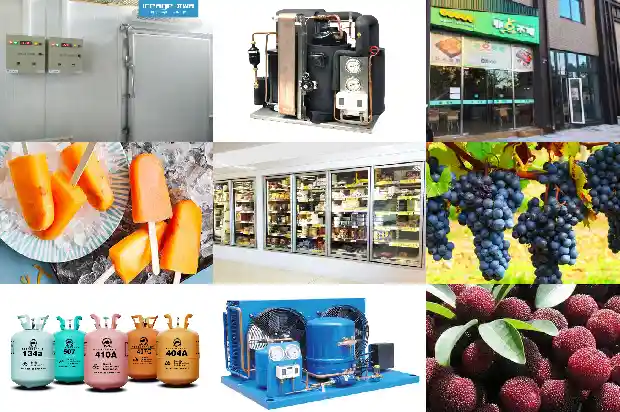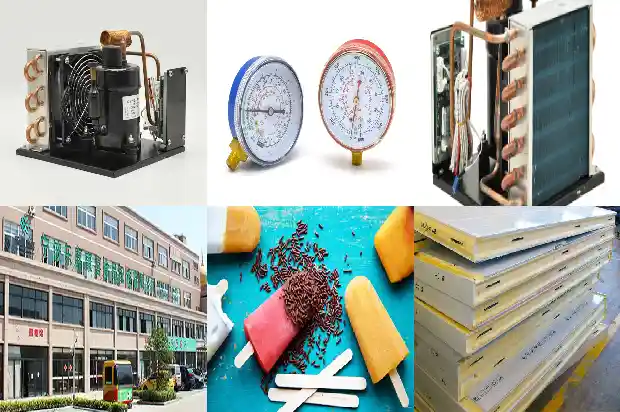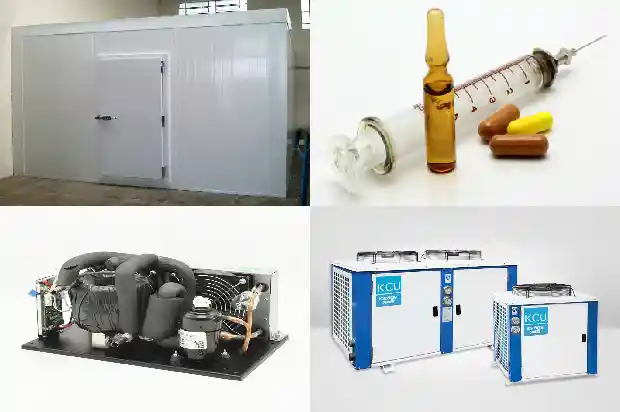Switching on and off procedures and operational logic of centrifugal chillers with cold water
2024-08-28
Centrifugal water chiller belongs to vapor compression refrigeration. Its refrigeration principle is that the compressor applies energy to the refrigerant vapor to increase its pressure and temperature. Then through condensation and throttling processes, it becomes low-pressure and low-temperature refrigerant liquid. The refrigerant liquid evaporates into vapor in the evaporator. At the same time, it obtains heat from the surrounding environment (such as the coolant, like cold water) to reduce the temperature of the coolant, thus achieving the purpose of refrigeration. Thus, it can be seen that the vapor compression refrigeration cycle includes four essential processes: compression, condensation, throttling, and evaporation.
Regarding the working principle of centrifugal compressors, there was a previous article. This article will talk about the switches, precautions, and working logic of centrifugal compressors.
Regarding the working principle of centrifugal compressors, there was a previous article. This article will talk about the switches, precautions, and working logic of centrifugal compressors.
- Precautions for centrifugal water chillers
Water with a temperature higher than 43°C must not flow into the evaporator or condenser. Otherwise, the refrigerant with excessive pressure will be discharged from the safety valve, causing refrigerant loss. Before starting the unit, the unit status should be checked to avoid situations that affect startup. When starting the unit, if the start interlock circuit is in any of the following states, even if the "start" button is pressed, the unit will not start:
(1) The inlet guide vane is not fully closed;
(2) The fault protection circuit has not been reset;
(3) The frequency converter is not ready;
(4) The oil temperature in the fuel tank is lower than 45°C;
(5) The motor winding temperature is higher than 60°C;
(6) The oil supply pressure difference is insufficient at 250 kPa (the difference between the oil supply pressure and the pressure in the fuel tank);
(7) The outlet water temperature of the chilled water is lower than the set value;
(8) The time interval for restarting the refrigerator after shutdown has not reached 20 minutes;
(9) The chilled water pump or cooling water pump is not running.
- Preparation and inspection contents before startup
Check the power supply: including the power supply of the main incoming cabinet, the power supply of the switch cabinet, and the double-headed changeover switch is in the normal position. The main unit control cabinet supplies power in sequence (waterway solenoid valve, cooling pump starter, chilled water pump starter, main unit switch cabinet closed). The line voltage is allowed to be ±5% as marked on the nameplate, and the maximum cannot exceed ±10%.
Check the water pressure: Open all waterway gate valves (except bypass valves) passing through the main unit heat exchanger. After the water pump is energized and started, observe whether the operating water pressure is normal.
Check the valves: Are the liquid stop valve, safety valve, and oil pressure valve fully opened?
Check the oil level: Is the oil level between the upper sight glass and the lower sight glass?
Note: When the chiller is continuously powered on for more than 12 hours and the oil temperature is preheated to 50°C; the cooling water pump, chilled water pump, and cooling tower are already running, and on the premise that a stable pressure difference of 0.1 MPa is established in the inlet and outlet water pressures of the evaporator and condenser, the main unit can be started.
Startup procedure: Turn on terminal equipment such as fan coil units → turn on chilled water pump and cooling water pump → turn on cooling tower fan (depending on the cooling water temperature) → turn on the main unit of the chiller. - Main control logic
- Start-stop control of chilled water pump
When starting the unit when the unit is in the shutdown state, the chilled water pump starts 5 minutes earlier than the oil pump. In the unit startup state (including standby), the chilled water pump is always in the startup state. After the unit is shut down normally, the chilled water pump is delayed by 5 minutes to shut down relative to the main motor. If the compressor stops due to fault protection, the chilled water pump is delayed to shut down. - Start-stop control of cooling water pump
When the unit starts, the cooling water pump starts 30 seconds later than the chilled water pump. In the unit startup state (including standby), the cooling water pump is always in the startup state. After the unit is shut down normally, the cooling water pump is delayed by 5 minutes to shut down relative to the main motor. If the compressor stops due to fault protection, the cooling water pump is delayed to shut down. - Compressor capacity regulation operation
According to the chilled water outlet temperature and the set PID parameters, automatically control the opening and closing of the guide vane and the frequency of the motor (for variable frequency motors) to adjust the compressor capacity and keep the chilled water outlet temperature constant at 7 ± 0.3°C. Capacity adjustment defines the following three actions: where the guide vane opening and motor frequency both refer to output values.
Capacity maintenance: Both the guide vane and motor frequency are maintained actions.
Capacity increase: Increase the guide vane opening or increase the motor frequency.
Capacity reduction: Reduce the motor frequency or reduce the guide vane opening. - Adjustment method of guide vane
Before the unit starts, the guide vane can be manually opened and closed throughout the entire range to check and adjust the limit switch of the electric actuator and the guide vane opening measurement circuit. After the system is powered on or a start command is issued, the guide vane will automatically close to zero. When starting up, whether the guide vane is manually adjusted or automatically adjusted, one of the three guide vane actions is executed in each cycle: maintain; increase the guide vane opening; reduce the guide vane opening.
After the guide vane enters automatic operation, it operates between 5% and 100%. The guide vane opening must not be less than 5%. After the unit starts up and the guide vane automatically opens to 10%, the guide vane can be manually opened and closed between 0% and 100%. At this time, pay attention to observing the chilled water outlet temperature and timely adjust the guide vane opening to ensure the normal operation of the unit.
Manual adjustment replaces the capacity adjustment PID algorithm, and all other protections are effective. When the guide vane given control mode is selected and the given value is set and the confirmation key is pressed, the guide vane will automatically open and close to the given value. When manually adjusting and switching the guide vane during shutdown, or when performing the shutdown action, the guide vane directly outputs according to the positioning value. - Compressor shutdown
The frequency of the variable frequency motor remains unchanged, and the guide vane is gradually closed to 10% (using the feedback opening as control. If the feedback opening does not reach the 20% position within 20 action cycles, the main motor will be directly turned off.). Turn off the main motor, close the guide vane to zero, and delay turning off the oil pump for 3 minutes.
- Control of compressor oil heater
The compressor oil heater is controlled by the oil heating AC contactor. Ensure that after the compressor stops, the oil tank temperature is maintained between 48 and 52°C. When the unit is started and the oil pump is turned on, the oil heater is disconnected. Otherwise, it operates according to the following conditions:
When the oil tank temperature is ≤48°C, the oil heater is turned on;
When the oil tank temperature is ≥52°C, the oil heater is disconnected;
When the oil tank temperature is between 48°C and 52°C, the oil heater contactor maintains its state.
When the oil tank temperature sensor fails, the oil heater is turned off and a fault is displayed, but the running main unit does not stop.
- Shutdown procedure
The shutdown procedure is the reverse of the startup procedure. First stop the main unit of the chiller → turn off the cooling tower fan → (after about 10 minutes) stop the cooling water pump → stop the chilled water pump (can be started and stopped according to the situation) → stop terminal equipment such as fan coil units.
If only the operation of the refrigerator needs to be stopped, simply pressing the "shutdown" button on the touch screen homepage can stop the refrigerator. After the refrigerator is shut down, the inlet guide vane will automatically close. The oil pump will automatically continue to run for another 3 minutes with a delay.
After the oil pump stops rotating, it will automatically stop the operation of the cooling water pump and cooling tower. In case of manual shutdown and out-of-control fault shutdown, the "emergency stop" switch on the control cabinet can be pressed to forcefully shut down the unit.
Related Articles
- Startup, Shutdown Procedures and Accident Handling of Various Pumps
- Cleaning Procedures and Methods for Cooling Towers and Heat Exchangers
- 8 Maintenance Procedures for Industrial Chillers
- Working Principle and Control Logic of Centrifugal Compressor
- What Are the Differences Between Chillers and General Water - cooled Equipment?
- Maintenance Strategies for the Working Cycle and Electrical Automatic Control of Chillers
- What are Refrigeration Equipment? What's the Principle of Chillers?
- Common Faults of Industrial Chillers
- Can You Solve These 4 Common Issues of Industrial Chillers?
- Common Faults and Corresponding Solutions of Chillers During Use
- How to Install and Maintain Industrial Chillers?
- Introduction to Lithium Bromide Absorption Chillers
- Effective Measures to Prevent Compressor Failures in Industrial Chillers
- Reference Points for Selection of Screw - type Chillers
- How to accurately choose water-cooled and air-cooled chillers?
- When to Consider Replacing Industrial Chillers
- Analysis and Treatment of Common Low-Pressure Faults in Chillers
- Analysis and Treatment of Common Low Pressure Faults in Chillers
